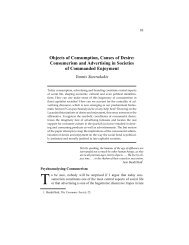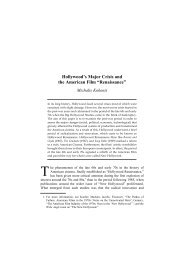19 International Symposium on Theoretical and Applied Linguistics ...
19 International Symposium on Theoretical and Applied Linguistics ...
19 International Symposium on Theoretical and Applied Linguistics ...
Create successful ePaper yourself
Turn your PDF publications into a flip-book with our unique Google optimized e-Paper software.
G E N E R A L S E S S I O N<br />
as thinking opportunities provided for students in the classroom, including recall <strong>and</strong> recogniti<strong>on</strong>,<br />
comparis<strong>on</strong>, abstract reas<strong>on</strong>ing, analysis etc. Intellectual dem<strong>and</strong> cannot be observed directly. It is<br />
mediated through language use in teacher-student interacti<strong>on</strong> in the classroom. A level of intellectual<br />
dem<strong>and</strong> too far below the intellectual capacity of students in their L1 is c<strong>on</strong>sidered a barrier to L2<br />
development.<br />
The pilot study explored the issue of intellectual dem<strong>and</strong> from a cross-lingual perspective. This<br />
perspective was taken because empirical evidence has proved that literacy skills in the L1 <strong>and</strong> L2 are<br />
str<strong>on</strong>gly related, <strong>and</strong> are manifestati<strong>on</strong>s of a comm<strong>on</strong> underlying proficiency (Cummins & Schecter,<br />
2003). Cross-lingual transfer is likely to occur in developing academic language proficiency, which is<br />
of prime c<strong>on</strong>cern in the study c<strong>on</strong>text. Cross-lingual transfer occurs between languages of the same<br />
family, <strong>and</strong> between remotely-related languages such as English <strong>and</strong> Chinese (see Geva & Wang,<br />
2001). While there is c<strong>on</strong>tinued need for high English proficiency pers<strong>on</strong>nel in the high-tech ec<strong>on</strong>omy<br />
in H<strong>on</strong>g K<strong>on</strong>g, the transferable proficiency possessed by students in their L1 such as higher order<br />
thinking skills etc. did not seem to be taken into c<strong>on</strong>siderati<strong>on</strong> in English curriculums or classroom<br />
practice, which was a major impetus of the study. A questi<strong>on</strong>, therefore, arose – can H<strong>on</strong>g K<strong>on</strong>g’s<br />
English language instructi<strong>on</strong> take advantage of students’ c<strong>on</strong>ceptual maturity in Chinese <strong>and</strong> use it for<br />
the benefit of their sec<strong>on</strong>d language learning?<br />
To undertake such a cross-lingual investigati<strong>on</strong>, we used detailed classroom interacti<strong>on</strong> data as a<br />
window to observe intellectual dem<strong>and</strong>. Corpus approach (a computer-assisted database) was chosen<br />
to carry out the study because of its capacity in processing large amounts of data <strong>and</strong> also the<br />
acknowledged inadequacy of available observati<strong>on</strong>al schemes (Allwright & Bailey, 2002). A corpus<br />
with two small sub-corpora (<strong>on</strong>e in English <strong>and</strong> the other in Chinese) was compiled for the pilot. The<br />
Chinese language sub-corpus was used as a benchmark for reference.<br />
In this paper we report the results, dilemmas <strong>and</strong> challenges encountered in the pilot corpus study.<br />
Issues such as determinati<strong>on</strong> of levels of intellectual dem<strong>and</strong>s <strong>and</strong> using L1 reference data are raised.<br />
Audience feedback will be valuable to the <strong>on</strong>-going research process.<br />
Chinese word inferiority effect: a test of Kao's model<br />
1 Chih-Wei Hue, 2 Yu-Hsiang Tseng, 3 Ching-Ching Lu,<br />
4 Chien-Hui Kao, 5 Yu-Fu Chen & 6 Yin-Wen Kou<br />
1,2,4,5&6 Nati<strong>on</strong>al Taiwan University & 3 Nati<strong>on</strong>al Hsinchu University of Educati<strong>on</strong><br />
1 hue@ntu.edu.tw, 2 r95227102@ntu.edu.tw, 3 cclu@mail.nhcue.edu.tw,<br />
4 d92227011@ntu.edu.tw, 5 r93227103@ntu.edu.tw & 6 93702032@nccu.edu.tw<br />
Character is the writing unit of Chinese, which is usually composed of a semantic <strong>and</strong> a ph<strong>on</strong>ological<br />
radical. A Chinese word usually c<strong>on</strong>sists of two syllables, or two characters. The characters in a text<br />
can be printed from left-to-right, right-to-left, or top-to-bottom.<br />
Chinese word inferiority effect (WIE) refers to the phenomena that the probability that a reader fails<br />
to detect a pair of positi<strong>on</strong> transposed characters (PTCs) embedded in text is higher, when the<br />
targeting characters are a word than not a word (Hue, <str<strong>on</strong>g>19</str<strong>on</strong>g>89). Different from the parafoveal-processing<br />
hypothesis Healy proposed to account for the English WIE (Hadley & Healy, <str<strong>on</strong>g>19</str<strong>on</strong>g>91), Kao, Hue, Tseng<br />
<strong>and</strong> Lo (in press) argued that Chinese WIE occurs because of two reas<strong>on</strong>s. First, when two PTCs are<br />
in parafovea, the visual informati<strong>on</strong> extracted from them is not sufficient to make detecti<strong>on</strong> because<br />
word is not reading unit of Chinese. Sec<strong>on</strong>dly, while the two PTCs are in fovea, their means can be<br />
integrated with that of their preceding characters before their visual informati<strong>on</strong> is fully processed.<br />
The purpose of the present research is to test further Kao et al.’s idea. Experiment 1 was a<br />
normative study. From news papers, 120 sentences were selected. Each sentence is composed of 27<br />
to 31 characters, <strong>and</strong> is written in two phrases. A key two-character word (noun) was selected from<br />
the sec<strong>on</strong>d phrase of a sentence. A cloze test was developed using them, with the key words<br />
substituted by blank spaces. From the resp<strong>on</strong>ses of 20 participants, the probability of resp<strong>on</strong>se (or<br />
predictability) of the key word of a sentence was computed.<br />
In Experiment 2, the fore menti<strong>on</strong>ed sentences were used as the stimuli of a detecti<strong>on</strong> task, <strong>on</strong>ly<br />
that for some of the high <strong>and</strong> some of the low predictable target words, the positi<strong>on</strong>s of their<br />
c<strong>on</strong>stituent characters were transposed. In the experiment, the sentences were presented <strong>on</strong>e at a<br />
time. When a sentence was presented, the participants were asked to detect a certain target item in it.<br />
There were two variables manipulated: type of target (a character c<strong>on</strong>taining of a particular radical VS.<br />
a pair of PTCs) <strong>and</strong> type of key word that embeds target (high VS. low predictability). The results<br />
<str<strong>on</strong>g>19</str<strong>on</strong>g> th ISTAL <str<strong>on</strong>g>19</str<strong>on</strong>g>






